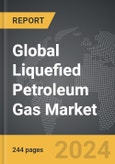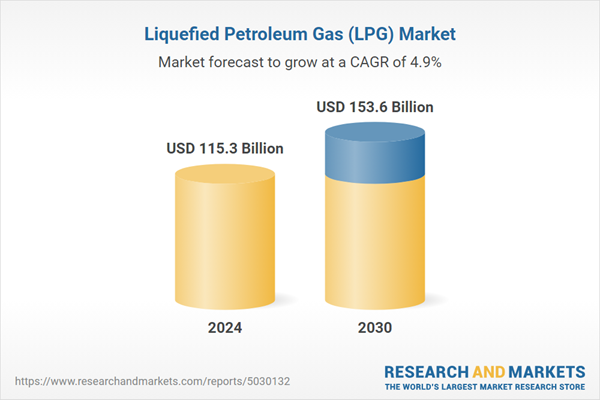Global Liquefied Petroleum Gas (LPG) Market - Key Trends & Drivers Summarized
Why Is Liquefied Petroleum Gas (LPG) a Vital Energy Source Globally?
Liquefied Petroleum Gas (LPG) plays a crucial role in the global energy landscape, serving as a versatile and efficient fuel for a wide range of applications, including residential heating, cooking, transportation, and industrial processes. LPG is prized for its clean-burning properties, producing fewer emissions compared to coal and oil, making it an important energy source in the transition to lower-carbon fuels. Its portability and ease of storage make LPG an ideal solution for areas lacking access to natural gas infrastructure, particularly in developing regions. As countries strive to reduce greenhouse gas emissions and improve air quality, the demand for LPG as an alternative to more polluting fossil fuels continues to rise. Additionally, LPG is increasingly being used as an autogas in vehicles, contributing to the global push towards cleaner transportation solutions.How Are Technological Advancements Impacting LPG Production and Usage?
Technological advancements are significantly enhancing the production, distribution, and usage of Liquefied Petroleum Gas (LPG), making it more efficient, cost-effective, and accessible. Innovations in extraction and processing techniques are improving the yield and quality of LPG, while advancements in storage and transportation technologies, such as the development of more efficient LPG tanks and cylinders, are expanding its availability. In the transportation sector, the development of LPG-powered engines and conversion kits is increasing the adoption of LPG as an autogas, offering a cleaner alternative to traditional gasoline and diesel fuels. Additionally, smart metering and remote monitoring technologies are enhancing the management of LPG distribution networks, improving supply chain efficiency and reducing costs. These technological improvements are driving the wider adoption of LPG across various sectors, supporting its role as a key transitional fuel in the global energy mix.What Market Trends Are Shaping the Demand for LPG?
Several key market trends are shaping the demand for Liquefied Petroleum Gas (LPG), including the global push for cleaner energy sources, the expansion of infrastructure in developing regions, and the growing adoption of LPG as an autogas. As governments implement policies to reduce carbon emissions and improve air quality, LPG is gaining traction as a cleaner alternative to coal and oil, particularly in residential and industrial applications. The expansion of LPG infrastructure, including the development of storage and distribution facilities, is increasing access to LPG in regions where natural gas is unavailable, driving demand in rural and remote areas. The growing use of LPG in the transportation sector, supported by the availability of LPG-powered vehicles and conversion kits, is further boosting demand, as consumers and businesses seek more environmentally friendly fuel options. Additionally, the increasing use of LPG in the petrochemical industry as a feedstock for producing chemicals and plastics is contributing to the market's growth.What Is Driving the Growth in the Liquefied Petroleum Gas (LPG) Market?
The growth in the Liquefied Petroleum Gas (LPG) market is driven by several factors. The increasing global demand for cleaner energy sources, particularly in residential, industrial, and transportation sectors, is a major driver, as LPG offers a low-carbon alternative to more polluting fossil fuels. Technological advancements in LPG production, storage, and distribution are enhancing the efficiency and accessibility of LPG, further driving market growth. The expansion of infrastructure in developing regions, where LPG is often the most viable energy option for households and businesses, is also contributing to the market's expansion. Additionally, the rising adoption of LPG as an autogas, supported by government incentives and the availability of conversion technologies, is boosting demand in the transportation sector. The growing use of LPG in the petrochemical industry as a feedstock for various products is further supporting market growth, as the demand for chemicals and plastics continues to rise globally.Report Scope
The report analyzes the Liquefied Petroleum Gas (LPG) market, presented in terms of units. The analysis covers the key segments and geographic regions outlined below.Segments: Source (Non-Associated Gas, Refinery, Associated Gas); End-Use (Domestic, Chemical, Industrial, Transport, Refinery Fuel, Commercial, Other End-Uses).
Geographic Regions/Countries: World; United States; Canada; Japan; China; Europe (France; Germany; Italy; United Kingdom; Spain; Russia; and Rest of Europe); Asia-Pacific (Australia; India; South Korea; and Rest of Asia-Pacific); Latin America (Argentina; Brazil; Mexico; and Rest of Latin America); Middle East (Iran; Israel; Saudi Arabia; United Arab Emirates; and Rest of Middle East); and Africa.
Key Insights:
- Market Growth: Understand the significant growth trajectory of the Non-Associated Gas segment, which is expected to reach US$115.4 Billion by 2030 with a CAGR of a 5.2%. The Associated Gas segment is also set to grow at 4.0% CAGR over the analysis period.
- Regional Analysis: Gain insights into the U.S. market, valued at $29.4 Billion in 2024, and China, forecasted to grow at an impressive 7.5% CAGR to reach $35.5 Billion by 2030. Discover growth trends in other key regions, including Japan, Canada, Germany, and the Asia-Pacific.
Why You Should Buy This Report:
- Detailed Market Analysis: Access a thorough analysis of the Global Liquefied Petroleum Gas (LPG) Market, covering all major geographic regions and market segments.
- Competitive Insights: Get an overview of the competitive landscape, including the market presence of major players across different geographies.
- Future Trends and Drivers: Understand the key trends and drivers shaping the future of the Global Liquefied Petroleum Gas (LPG) Market.
- Actionable Insights: Benefit from actionable insights that can help you identify new revenue opportunities and make strategic business decisions.
Key Questions Answered:
- How is the Global Liquefied Petroleum Gas (LPG) Market expected to evolve by 2030?
- What are the main drivers and restraints affecting the market?
- Which market segments will grow the most over the forecast period?
- How will market shares for different regions and segments change by 2030?
- Who are the leading players in the market, and what are their prospects?
Report Features:
- Comprehensive Market Data: Independent analysis of annual sales and market forecasts in US$ Million from 2024 to 2030.
- In-Depth Regional Analysis: Detailed insights into key markets, including the U.S., China, Japan, Canada, Europe, Asia-Pacific, Latin America, Middle East, and Africa.
- Company Profiles: Coverage of players such as Aegis Logistics Ltd., Air Liquide Australia Limited, ANGOLA LNG MARKETING LTD, Aygaz A.S., badenova AG and Co.KG and more.
- Complimentary Updates: Receive free report updates for one year to keep you informed of the latest market developments.
Some of the 41 companies featured in this Liquefied Petroleum Gas (LPG) market report include:
- Aegis Logistics Ltd.
- Air Liquide Australia Limited
- ANGOLA LNG MARKETING LTD
- Aygaz A.S.
- badenova AG and Co.KG
- Bharat Petroleum Corporation Ltd.
- Bison Engineering
- BW LPG
- C3 Biotechnologies
- Calor Gas Ltd.
Tariff Impact Analysis: Key Insights for 2025
Global tariff negotiations across 180+ countries are reshaping supply chains, costs, and competitiveness. This report reflects the latest developments as of April 2025 and incorporates forward-looking insights into the market outlook.The analysts continuously track trade developments worldwide, drawing insights from leading global economists and over 200 industry and policy institutions, including think tanks, trade organizations, and national economic advisory bodies. This intelligence is integrated into forecasting models to provide timely, data-driven analysis of emerging risks and opportunities.
What’s Included in This Edition:
- Tariff-adjusted market forecasts by region and segment
- Analysis of cost and supply chain implications by sourcing and trade exposure
- Strategic insights into geographic shifts
Buyers receive a free July 2025 update with:
- Finalized tariff impacts and new trade agreement effects
- Updated projections reflecting global sourcing and cost shifts
- Expanded country-specific coverage across the industry
Table of Contents
Companies Mentioned (Partial List)
A selection of companies mentioned in this report includes, but is not limited to:
- Aegis Logistics Ltd.
- Air Liquide Australia Limited
- ANGOLA LNG MARKETING LTD
- Aygaz A.S.
- badenova AG and Co.KG
- Bharat Petroleum Corporation Ltd.
- Bison Engineering
- BW LPG
- C3 Biotechnologies
- Calor Gas Ltd.
Table Information
| Report Attribute | Details |
|---|---|
| No. of Pages | 244 |
| Published | April 2025 |
| Forecast Period | 2024 - 2030 |
| Estimated Market Value ( USD | $ 115.3 Billion |
| Forecasted Market Value ( USD | $ 153.6 Billion |
| Compound Annual Growth Rate | 4.9% |
| Regions Covered | Global |









